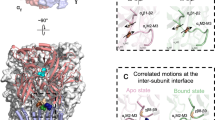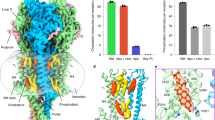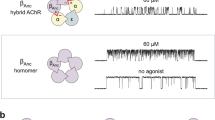Abstract
LIGAND-gated ion channels, a major class of cell-surface proteins, have a pseudosymmetric structure with five highly homologous subunits arranged around a central ion pore1. The correct assembly of each channel, whose subunit composition varies with cell type and stage of development, requires specific recognition between the subunits2–4. Assembly of the pentameric form of the acetylcholine receptor from adult muscle (AChR; α2βɛδ) proceeds by a stepwise pathway starting with the formation of the hetero-dimers, αe and α δ. The heterodimers then associate with the β subunit and with each other to form the complete receptor5–7,21. We have now determined which parts of the subunits mediate the interactions during assembly of the adult form of the receptor from mouse muscle by using a chimaeric subunit in which the N-terminal and C-terminal extracellular domains are derived from the ɛ subunit with the remainder from the β subunit. The e and β subunits were chosen because the subunit forms a heterodimer with the a subunit in the pathway for assembly of the receptor,whereas the β subunit does not. The ɛβ chimaera can substitute for the ɛ but not the β subunit in the oligomeric receptor, indicating that the a subunit specifically recognizes an extracellular domain of the e subunit.
This is a preview of subscription content, access via your institution
Access options
Subscribe to this journal
Receive 51 print issues and online access
$199.00 per year
only $3.90 per issue
Buy this article
- Purchase on Springer Link
- Instant access to full article PDF
Prices may be subject to local taxes which are calculated during checkout
Similar content being viewed by others
References
Unwin, N. Neuron 3, 665–676 (1989).
Mishina, M. et al. Nature 321, 406–411 (1986).
Gu, Y. & Hall, Z. W. Neuron 1, 117–125 (1988).
Betz, H. Neuron 5, 383–392 (1990).
Gu, Y. et al. Neuron (in the press).
Blount, P. & Merlie, J. P. Neuron 3, 349–357 (1989).
Blount, P. et al. J. Cell Biol. 111, 2601–2611 (1990).
Gu, Y. et al. Neuron 5, 147–157 (1990).
Rose, J. K. & Doms, R. W. A. Rev. Cell Biol. 4, 257–288 (1988).
Hurtley, S. M. & Helenius, A. A. Rev. Cell Biol. 5, 277–307 (1989).
Gullick, W. & Lindstrom, J. Biochem. 22, 3312–3320 (1983).
Doyle, C. J. et al. J. Cell Biol. 103, 1193–1204 (1986).
Varghese, J. N. et al. Nature 303, 35–40 (1983).
Johnson, J. D. et al. Proc. natn. Acad. Sci. U.S.A. 85, 7516–7520 (1988).
Manolios, N. et al. Science 249, 274–277 (1990).
Numa, S. et al. Cold Spring Harb. Symp. quant. Biol. 48, 57–69 (1983).
Claudio, T. in Frontiers in Molecular Biology: Molecular Neurobiology (eds Glover, D. M. & Hames, B. D.) 63–142 (IRL, Oxford, 1989).
Buonanno, A. et al. J. biol. Chem. 264, 7611–7616 (1989).
Geisselsoder, J. et al. Biotechniques 5, 786–791 (1987).
Kunkel, T. A. Proc. natn. Acad. Sci. U.S.A. 82, 488–492 (1985).
Gu, Y. et al. J. Cell Biol. (in the press).
Author information
Authors and Affiliations
Rights and permissions
About this article
Cite this article
Yu, XM., Hall, Z. Extracellular domains mediating ɛ subunit interactions of muscle acetylcholine receptor. Nature 352, 64–67 (1991). https://doi.org/10.1038/352064a0
Received:
Accepted:
Issue Date:
DOI: https://doi.org/10.1038/352064a0
This article is cited by
Comments
By submitting a comment you agree to abide by our Terms and Community Guidelines. If you find something abusive or that does not comply with our terms or guidelines please flag it as inappropriate.



